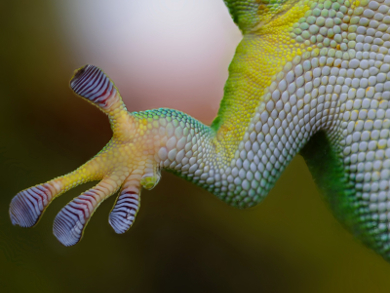Many species of geckos have toepads that can reversibly stick to almost any surface. This allows them to walk on walls or ceilings. The effect is caused by a hierarchical fibrillar structure of the toe pads. They not only provide reversible adhesion, but are also self-cleaning under dry conditions. Within only four steps, about 80 % of the particles stuck to a gecko’s feet are removed. This is due to the fact that small particles stick better to, e.g., a wall than to a small number of the fibrils on the gecko’s toes. Researchers have attempted to recreate these properties in artificial surfaces. However, so far, the synthesized structures have only achieved the removal of 55 % of the collected particles within 30 steps.
Quan Xu, China University of Petroleum, Beijing, Liping Heng, Beihang University, Beijing, and colleagues have developed dry self-cleaning, mechanically strong, scratch-resistant surfaces with reversible adhesion inspired by gecko toe pads. The team created a layered surface composed of montmorillonite (MMT), a phyllosilicate mineral, and hydroxyethyl cellulose (HEC). The material was synthesized by preparing a dispersion of MMT in water, adding an HEC solution, stirring the mixture for 24 h and finally, pouring it onto a silicon template and evaporating the solvent.
The prepared surface features vertical columns with diameters of about 5 μm based on a layered structure. The material has strong adhesion properties. The surface’s self-cleaning properties were tested using hydrophilic Al2O3 particles and lipophilic polystyrene particles. Up to 59 % of the polystyrene particles and up to 46 % of the Al2O3 particles were dislodged within five “steps”. According to the researchers, the biomimetic material could be useful, e.g., as reusable adhesives, in aerospace technology, or in biomedical applications.
- Tough Reversible Adhesion Properties of a Dry Self-Cleaning Biomimetic Surface,
Ming Li, Quan Xu, Xu Wu, Weijun Li, Wenjie Lan, Liping Heng, Jason Street, Zhenhai Xia,
ACS Appl. Mater. Interfaces 2018.
https://doi.org/10.1021/acsami.8b08501




The work is very innovative, providing a new method of particle sieving and greatly improved self-cleaning performance.